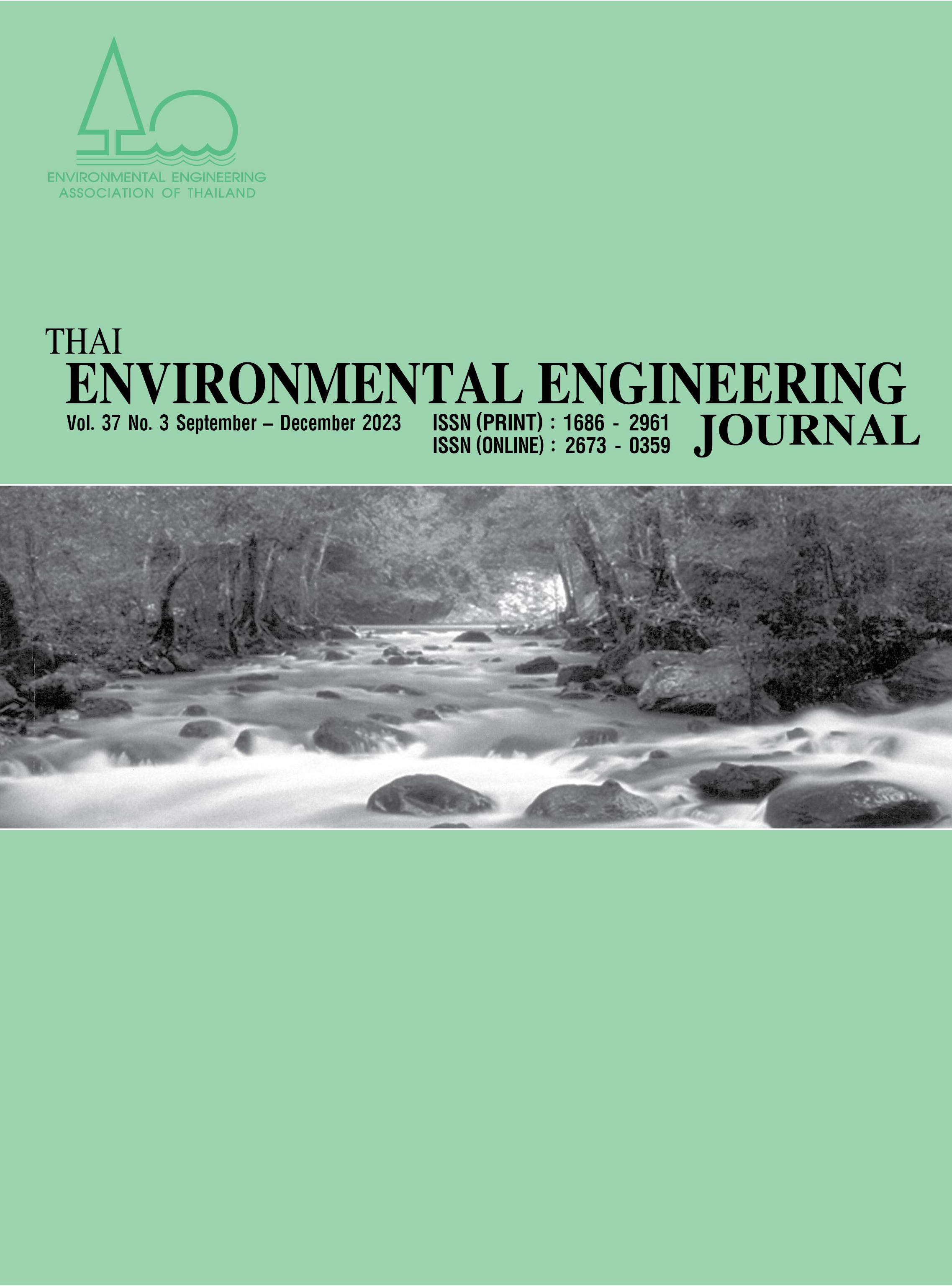Evaluation of Green Roof Performance in Slowing Down Stormwater Runoff in Urban Catchment, The Case of Samut Prakan, Thailand
Main Article Content
Abstract
Urbanization implies a reduction of vegetation leading to an increase of bare lands coverage and the expansion of impervious surfaces. Such circumstances are significantly influence the hydrological cycle, reduce evapotranspiration losses, and accumulate surface runoff, raising the risk of floods, particularly in rapidly developing urban areas. Green roofs are considered as one of the most suitable Green Infrastructure (GI) for densely urbanized areas because they can incorporate into new construction or added to existing buildings during renovation or reroofing without further land consumption. This study aims to evaluate the effectiveness of green roofs in helping to slow down water runoff in response to flood risks in Samut Prakan municipal area. The hydrological model EPASWMM 5.1 was created with rain estimated based on historical data and the green roof installation scenarios. 12 green roof scenarios, consisting of 4 main scenarios, are categorized based on the rainfall events (average extreme rainfall, 10-year return period, 20-year return period, 50-year return period). The simulation results show that green roofs significantly reduce surface runoff and peak flow. Specifically, extensive green roofs in Samut Prakan achieved runoff reduction rates of 14.6% to 54.51%, and peak flow reduction rates of 7.43% to 19.6%. Considering the runoff reduction rate, green roof can provide more hydrological benefit than that of traditional storm management system. While the performance of green roofs in tropical climates may be less effective compared to those in arid and temperate zones, the results of this study are consistent with previous research and provide valuable insights for optimizing green roof design and implementation in tropical country as Thailand.
Article Details
References
Ajjur, S.B. and Al-Ghamdi, S.G. 2022. Exploring urban growth–climate change–flood risk nexus in fast growing cities. Scientific Reports 12, 12265 (2022).
Koc, K. And Işik, Z. 2020. A multi-agent-based model for sustainable governance of urban flood risk mitigation measures, Natural Hazards 104(1).
Ekmekcioğlu, Ö., Yilmaz, M., Özger, M. And Tosunoğlu, F. 2021. Investigation of the low impact development strategies for highly urbanized area via auto-calibrated Storm Water Management Model (SWMM). Water Sci Technol 2021. 84 (9): 2194–2213.
Webber, J.L., et al. 2019. Is green infrastructure a viable strategy for managing urban surface water flooding? Urban Water Journal. 17(7):1-11.
Berndtsson, J. C. 2010. Green roof performance towards management of run-offwater quantity and quality: a review. Ecological Engineering, 36,351–360.
Renato Castiglia Feitosa and Sara Wilkinson 2016 Modelling green roof stormwater response for different soil depths. Landscape and Urban Planning 153 (2016) 170–179
Li, Y. and Babcock, R. 2014. Green roof hydrologic performance and modeling: a review. Water Science & Technology 69(4):727-738.
Kohler, M., et al. 2002. Green roofs in temperate climates and in the hot-humid tropics – far beyond the aesthetics. Environmental Management and Health 13(4):382-391.
Yoon J. 2013. Urban design mitifation tools for heavy rainfall hazard: Focusing on the flooding hazzard area in Gamjeon-1 Dong, Busan. Dong-a University Master's Thesis.
F. Viola, M. Hellies, R. Deidda. 2017. Retention performance of green roofs in representative climates worldwide. Journal of Hydrology 553 (2017) 763–772.
Iana F. Grullon., et. al. 2020. Green roofs in the tropics: design considerations and vegetation dynamics. Heliyon 6 (2020) e04712.
Musa Akther., et al. A Review of Green Roof Applications for Managing Urban Stormwater in Different Climatic Zones. Sustainability 2018, 10, 2864.
Nicholas S.G. Williams, John P. Rayner, and Kirsten J. Raynor (2010). Green roofs for a wide brown land: Opportunities and barriers for rooftop greening in Australia. Urban Forestry & Urban Greening 9 (2010) 245–251.
Nur Fitriah Isa., et.al. 2020. Green roof performance under malaysia tropical climates: a review. Indonesian Journal of Electrical Engineering and Computer Science. Vol. 18, No. 2, May 2020, pp. 614-62.
Shin, E. and Kim, H. 2015. Analysing Green Roof Effects in an Urban Environment: A Case of Bangbae-dong, Seoul. Journal of Asian Architecture and Building Engineering. 14(2).
Rossman, L.A. 2015. Storm Water Management Model User’s Manual Version 5.1.
Palla, A. and Gnecco, I. 2015. Hydrologic modeling of Low Impact Development systems at the urban catchment scale. Journal of Hydrology 528 (2015) 361-368.
Sims, A., Albers, B., and Kesteloot, C. 2016. Effect of climate on stormwater retention performance of extensive green roofs. Ecological Engineering, 95, 210-219.
Locatelli, L., Mark, O., Mikkelsen, P. S., Arnbjerg-Nielsen, K., and Jensen, M. B. 2014. Green roofs as a tool for solving the rainwater runoff problem in the urbanized 21st century? A review. Urban Climate, 10, 408-442.
Kasmin, H., Stovin, V.R., and Hathway, E.A., 2010. Towards a generic rainfall-runoff model for green roofs. Water Sci. Technol. 62 (4), 898–905.
Liu, X and Chui, T.F.M. 2019. Evaluation of Green Roof Performance in Mitigating the Impact of Extreme Storms. Water 2019, 11(4), 815.
Liu, L., Sun. L, Niu. J, and Riley, W.J. 2020. Modeling Green Roof Potential to Mitigate Urban Flooding in a Chinese City. Water 2020, 12, 2082; doi:10.3390/w12082082


